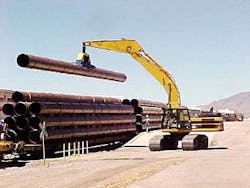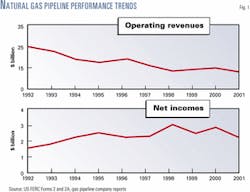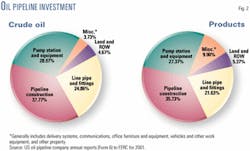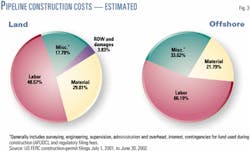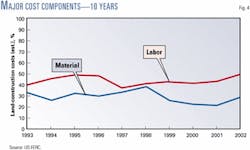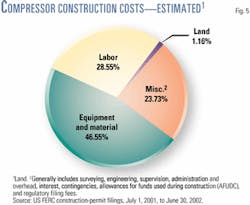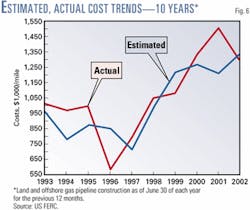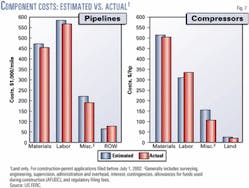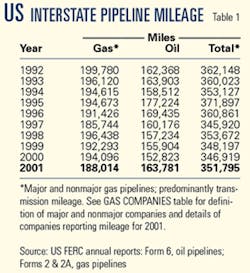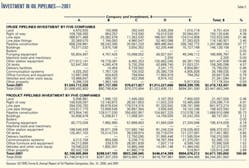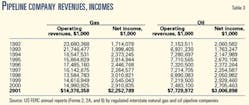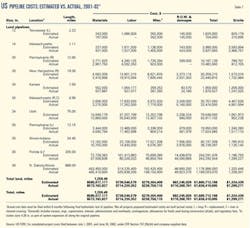US natural gas interstate pipeline companies continue to be optimistic about demand in developing markets, according to applications filed before the US Federal Energy Regulatory Commission through June 30, 2002.
For the second year in a row, companies' plans emphasize adding compression to current systems. For the most recent 12-month survey period, however, plans to add pipe to existing delivery systems also increased over the comparable period ending in mid-2001.
And annual reports filed with FERC confirm the current expansion of natural gas delivery capacity as investments in gas plant jumped for calendar year 2001. Elevated wellhead prices throughout the year, driven by rosy demand forecasts, also pushed companies' operating revenues higher.
Other filings with FERC for the 12-month period ending June 30, 2002, indicate that actual costs of past compressor station and pipeline installation nearly matched those originally estimated.
Gathering the data
This report is based on publicly available information from FERC that falls into two broad categories:
- Data from annual reports filed by regulated oil and natural gas pipeline companies with FERC for the previous calendar year.
- Data from periodic filings with FERC by those regulated natural gas pipelines related to capacity-expansion plans that FERC must approve. Oil & Gas Journal keeps a record of those filings during each 12-month period ending June 30.
•Annual reports. Companies that, in FERC's determination, are involved in the interstate commerce of moving oil or natural gas for a fee are "jurisdictional" to FERC, must apply to FERC for approval of its transportation rates, and therefore must file a FERC annual report: Form 2 or 2A for major or nonmajor natural gas pipelines; Form 6 for oil (crude or product) pipelines.
The deadline each year is Apr. 1. For a variety of reasons, many companies miss that deadline, apply for extensions, but eventually file an annual report. OGJ begins in March requesting copies of these reports directly from the companies.
That deadline and the numerous delayed filings explain why publication of this OGJ report on pipeline economics occurs as late as the third quarter of each year. Earlier publication would preclude many companies' information.
•Petitions for "public convenience and necessity." When a FERC-regulated natural gas pipeline company wishes to modify its system, it must petition for a "certificate of public convenience and necessity." This filing must explain in detail the planned construction, justify it, and-except in certain instances-specify what the company estimates the construction will cost.
Not all applications are approved; not all that are approved are built. But, assuming a company receives its certificate and builds its facilities, it must-again, with some exceptions-report back to FERC how its original cost estimates compare with what it actually spent.
OGJ spends the year July 1 to June 30 monitoring these filings, collecting them, and grouping and collating their numbers.
US pipelines
Reports filed by regulated US interstate natural gas and common carrier oil pipelines to FERC for 2001 permit analysis of these companies and their systems.
Two large tables (see pdfs at bottom of page) offer a variety of data for US pipeline companies: revenue, income, volumes transported, miles operated, and investments in physical plants. For 2001, OGJ has begun reporting what natural gas pipeline companies spent during the year on maintenance.
The table on natural gas companies has tracked how the US gas-transmission industry has changed under lessening regulation. OGJ's exclusive, annual Pipeline Economics Report began tracking volumes of gas transported for a fee by major interstate pipelines for 1987 (OGJ, Nov. 28, 1988, p. 33) as pipelines moved gradually after 1984 from owning the gas they moved to mostly providing transportation services. Beginning with 2001 data, the table only lists volumes transported for others.
The company tables have also reflected the asset consolidation and merger activity among companies over the past 3-5 years in their efforts to improve transportation efficiencies and increase bottom lines. A separate sidebar in this year's report presents some of the most important mergers in an effort to help OGJ readers keep track of changing companies names, affiliations, and assets.
Comparisons
FERC's reporting rules have changed over the years and make comparing annual US petroleum and natural gas pipeline data, especially mileage, difficult. For any calendar year, for example, how many companies are required to file reports with FERC may vary, as some companies become jurisdictional, others are declared non-jurisdictional, and still others are merged or consolidated out of existence.
FERC's two-tier classification system for natural gas pipeline companies after 1984 further complicates comparisons (OGJ, Nov. 25, 1985, p. 55).
Definitions of the categories can be found at the end of the company table for gas pipeline companies and in FERC Accounting and Reporting Requirements for Natural Gas Companies, para. 20.011.
Only major US gas pipelines are required to file miles operated in a given year. The other companies ("non-major") may indicate miles operated but are not specifically required to do so.
For several years after 1984, many non-majors did not describe their systems. But over time, filing descriptions of their systems has become more common, and most have been providing miles operated.
Reports for 2001 show a rise in FERC-defined major gas pipeline companies to 63 of 110 from 61 major companies among 113 filing for 2000.
FERC made an additional change to reporting requirements for 1995 for oil pipelines, which includes crude oil and petroleum products.
Exempt from requirements to prepare and file a Form 6 were those pipelines whose operating revenues have been at or less than $350,000 for each of the 3 preceding calendar years.
These companies must now file only an "Annual Cost of Service Based Analysis Schedule," which provides only total annual cost of service, actual operating revenues, and total throughput in both deliveries and barrel-miles.
Whether FERC designates an oil pipeline company an interstate common-carrier pipeline determines whether the company must file an annual report.
More changes came for 1996: Major natural gas pipeline companies were no longer required to report miles of gathering and storage systems separately from transmission.
Thus, total miles operated for gas pipelines consist almost entirely of transmission mileage. To continue to convey a 10-year trend, Table 1 has been adjusted to reflect only transmission mileage operated since 1992.
Deliveries
For 2001, gas pipelines gathered and moved more than 30.7 tcf of other companies' gas, a nearly 4% drop over volumes moved in 2000.
Oil pipelines moved more than 7.5% fewer barrels in 2001, with most of the decline coming in product movements, which were off by 1.2 billion bbl (delivered), or nearly 17%. Crude oil movements were down nearly 160 million bbl, or more than 2% from deliveries in 2000.
Some of the explanation may be found in crude oil and product prices firming in second half 2001, after slightly sagging earlier in that year, and they have held at historically high levels well into 2002. As of late last month, crude oil prices in world trade moved over $30/bbl as the Organization of Petroleum Exporting Countries announced it was leaving production alone, promising no relief in sight for consumers in the world's largest energy market.
Trunkline-traffic (1 bbl moving 1 mile = 1 bbl-mile) for US crude oil and product pipelines was flat for 2001 with crude oil traffic declining by more than 2% offset by a nearly 2% rise in product traffic.
Rankings
FERC annual reports provide data to rank the top 10 US oil and gas pipe- line companies. (See accompanying tables.)
Year after year, companies' positions in these rankings shift, with some dropping out and others dropping in, and reflect normal fluctuations in companies' activities and fortunes. Because these companies comprise such a large portion of their respective groups, however, the listings provide snapshots of overall industry trends and events.
Operating revenues and incomes for all companies offer a view of the conditions of these industries (Fig. 1; Table 3).
Calculating return on investment-net income as a portion of gas-plant investment-can also serve as a measure of companies' performances and health. The term "gas plant" refers to the physical facilities used to move natural gas: compressors, metering stations, and pipelines.
A downward trend since 1995 but bucked in 2000 was resumed in 2001 as net income as a percentage of gas-plant investment stood at 3.8% for all companies. In 2000, it was more than 4.2%, compared with 3.8% in 1999. In 1998, it was 4.7%; 1997, 3.8%; 1996, slightly more than 4%; 1995, 4.9%.
For the early 1990s, this indicator of companies' health had risen steadily. In 1984, it stood at 8.7%-the year FERC began (with Order 436) restructuring the interstate gas-pipeline industry, culminating in 1992 with Order 636.
Beginning with 1985, net income as a portion of gas-plant investment fell precipitously through 1987 then began a gradual comeback.
All gas pipeline companies (majors and non-majors in 2001) reported an industry gas-plant investment totaling almost $71 billion, up from $68 billion in 2000, from nearly $66 billion in 1999, from more than $63 billion in 1998, and from almost $60 billion in 1997.
For oil pipeline companies in 2001, net income as a percentage of investment in carrier property was nearly level with that for 2000 at slightly more than 9%, up still from 8.6% in 1999, which had reversed a 2-year decline: 6.8% in 1998 and 7.3% in 1997.
Actual investment in carrier property rose by more than 8% after falling in 2000 by more than 12%, bucking an overall upward trend since 1990. Carrier property had increased in 1999 to more than $33.8 billion from $30.1 billion in 1998 and $30.6 billion in 1997.
Oil & Gas Journal for several years has tracked carrier-property investment by five crude oil pipeline and five products pipeline companies chosen as representative in terms of physical systems and expenditures (Table 2).
For 2001, the five crude oil pipeline companies reduced their overall investment in carrier property by only a fraction, less than 1%, over that for 2000. The five products pipeline companies increased theirs, however, by more than 10%. And this follows an almost 5% increase in 2000 over 1999.
The trend in the 1990s had been steadily higher: $2.3 billion for 1997, $2.1 billion in 1996, $2 billion for 1995, and $1.97 billion for 1994.
But in 1998, a major crude oil pipeline company that had been part of this list merged with two other large pipeline companies. Comparisons with earlier years must, therefore, be qualified.
More mergers have followed, making comparisons with previous years less reliable.
In 2001, investment by the five product pipeline companies was more than $4.6 billion, continuing a trend evident for much of the 1990s: more than $4.2 billion in 2000; barely more than $4 billion in 1999; nearly $3.8 billion in 1998; slightly less than $3.7 billion in 1997; $3.6 billion in 1996; $3.5 billion in 1995; and $3.3 billion in 1994.
Fig. 2 illustrates the investment split in the crude oil and products pipeline companies.
Another measure of the profitability of oil and natural gas pipeline companies in recent years is the portion net income represents of operating income (Table 3).
For oil pipelines, the percentage of income in operating revenues had been hovering in the mid-20s for the first 5 years of the 1990s; for the last 7 years, however, it pushed into the 30s, reaching almost 39% in 2001.
Construction
Annual tracking of the mileage and compression horsepower applied for and of the estimated costs indicates future construction. And Oil & Gas Journal has been doing that since this report began more than 40 years ago.
Tables 4 and 5 show natural gas pipeline companies' estimates during the period July 1, 2001, to June 30, 2002, for what it will cost to construct a pipeline or install new or additional compression.
Those tables cover a variety of locations, pipeline sizes, and compressor-horsepower ratings.
Continued push
For any period, not all projects that are proposed are approved; not all approved ones are eventually built. OGJ's twice-yearly construction survey tracks those that proceed.
Applications filed in the 12 months ending June 30, 2002, suggest the immediate future of gas-pipeline construction on US interstate system:
•More than 1,660 miles of pipeline were proposed for land construction; 70 miles for offshore expansions.
This compares with more than 1,100 miles of land pipeline proposed for the 12 months before June 30, 2001 (Table 4).
•More than 550,000 hp of new or additional compression were applied for, compared with nearly 514,000 hp for the same period the year before (Table 5). (All applications are for land-based compression.)
And those compression projects tell the year's story:
•For the second year in a row, more than half a million horsepower of new or additional compression are envisioned by companies taking the fast track to expanding their gas deliveries into the growing US markets in the West, Northeast, and Florida.
•Of the total amount of compression to be built, nearly 60% (more than 330,000 hp) is for added capacity at existing stations.
Companies clearly believe they can meet expected higher gas demand early if they expand existing compression capacity. Much of this added compression is tied to pipeline looping of existing systems (Table 4), also easier and quicker to get approved than new pipeline over virgin right-of-way.
Table 4 lists 83 land-pipeline construction "spreads," or mileage segments, and three marine projects, compared with:
- 49 land and 2 marine projects (OGJ, Sept. 3, 2001, p. 66).
- 115 land and 6 marine projects (OGJ, Sept. 4, 2000, p. 68).
- 39 land and no marine projects (OGJ, Aug. 23, 1999, p. 45).
- 34 land and 2 marine projects (OGJ, Aug. 31, 1998, p. 33).
- 35 land and 4 marine projects (OGJ, Aug. 4, 1997, p. 37).
Reports for 1997 and 1998 included data from Canada.
For the 12 months ending June 30, 2002, the 86 projects would cost more than $2.1 billion.
Projects' cost projections indicate much about where companies believe unit construction costs ($/mile) are headed. These cost-per-mile figures in fact reveal more about cost trends than do aggregate totals.
In the 2001-02 period, for proposed US gas-pipeline projects, the average land cost per mile was more than $1.2 million; for offshore, $1.5 million. For the 2000-01 period, the land pipeline projects' costs averaged slightly more than $1.3 million/mile; for the offshore projects, more than $2.5 million/mile.
Components
Variations year-to-year in the four major categories of pipeline construction costs-material, labor, miscellaneous, and right-of-way (ROW)-can also suggest trends within each group.
Materials can include line pipe, pipe coating, and cathodic protection.
"Miscellaneous" costs generally cover surveying, engineering, supervision, contingencies, telecommunications equipment, freight, taxes, allowances for funds used during construction (AFUDC), administration and overheads, and regulatory filing fees.
ROW costs include obtaining right-of-way and allowing for damages.
For the 83 land spreads surveyed for the 2001-02 period covered here, costs-per-mile for the four categories were as follows:
- Material-$361,722/mile.
- Labor-$589,404/mile.
- Miscellaneous-$215,942/mile.
- ROW and damages-$46,504/mile.
For the three offshore spreads for the same period, costs-per-mile for three categories (no ROW) were as follows:
- Material-$328,115/mile.
- Labor-$680,443/mile.
- Miscellaneous-$497,258/mile.
Table 4 lists proposed pipelines in order of increasing size (OD) and increasing lengths within each size.
The average cost per mile for the projects shows few clear-cut trends related to either length or geographic area.
In general, however, the cost per mile within a given diameter indicates that the longer the pipeline, the lower the unit (per-mile) cost for construction. And, lines built nearer populated areas tend to have higher unit costs.
Additionally, road, highway, river, or channel crossings and marshy or rocky terrain each strongly affects pipeline construction costs.
Fig. 3, derived from Table 4, shows the major cost-component splits for land and offshore pipeline construction costs.
Material and labor for constructing land pipelines make up nearly 79% of the cost; for offshore lines, nearly 67%. Fig. 4 plots a 10-year comparison of land-construction unit costs for the two major components, material and labor.
Fig. 5 shows the cost split for land compressor stations based on data in Table 5.
Table 6 lists 10 years of unit land-construction costs for natural gas pipelines with diameters ranging from 8 to 36 in. The table's data consist of estimated costs filed under CP dockets with FERC, the same data shown in Tables 4 and 5, with some data during occasional years provided by Canada's National Energy Board.
Table 6 shows that the average cost per mile for any given diameter may fluctuate year to year as projects' costs are affected by geographic location, terrain, population density, or other factors.
Completed projects' costs
A natural gas pipeline company must file with FERC what it has actually spent on an approved and built project. This filing must occur within 6 months after the pipeline's successful hydrostatic testing or the compressor's being placed in service.
Fig. 6 shows 10 years of estimated vs. actual costs on cost-per-mile bases for project totals.
Tables 7 and 8 show such actual costs for pipeline and compressor projects reported to FERC during the 12 months ending June 30, 2002. Fig. 7, for the same period, depicts how total actual costs ($/mile) for each category compared to estimated costs.
Some of these projects may have been proposed and even approved much earlier than the 1-year survey period. Others may have been filed for, approved, and built during the survey period.
If a project was reported in construction spreads in its initial filing, that's how projects are broken out in Table 4.
Completed-projects' cost data, however, are usually reported to FERC for an entire filing, usually but not always separating pipeline from compressor-station (or metering site) costs and lumping several diameters together.
Overall, estimated gas-pipeline construction costs exceeded actual ones by more than $44 million; the figures are for land construction, as no offshore construction costs were reported during the survey period.
Table 8 shows that estimated costs for installing compression exceeded actual by more than $14.5 million.
Click here to view US Pipeline Costs, Estimated PDF
Click here to view US Compressor Cost, Estimated PDF
Click here to view 10 Years of Land Construction Costs1 PDF
Click here to view US Compressor Costs: Estimated vs Actual, 2001-02* PDF
Click here to view Oil Pipelines PDF
Click here to view Gas Pipeline PDF
